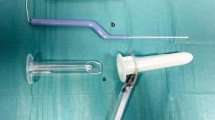Abstract
We aimed to analyze the results of 5-year consecutive use of the hemorrhoidal laser procedure (HeLP) in patients with second- to third-grade hemorrhoids with minimal or moderate mucosal prolapse. A total of 189 patients were treated between April 2012 and October 2017. We reported perioperative complications, postoperative pain, improvement of hemorrhoids grade, and relapse of hemorrhoidal disease (HD). Improvement of symptoms was assessed using the Patient Global Improvement (PGI) Scale. No severe intraoperative complications were observed. The median follow-up was 42 months (range 6–62 months). Pain after surgery was absent in 94% of patients. No cases of rectal tenesmus or alterations of defecation habits were reported. Symptoms and HD improvement reached a “plateau” at 3 to 6 months following surgery. We observed a significant decrease in HD degree, occurrence of bleeding, pain, itching, and acute HD. Complete resolution of HD was reported in > 60% of patients 1 year after surgery. The individual level of improvement in symptoms was consistent (very much and much improved, according to PGI-I score) for about 90% of patients during the follow-up. This study confirmed that the HeLP is a safe, painless, and effective procedure for the treatment of HD in selected cases.

Similar content being viewed by others
References
Riss S, Weiser FA, Schwameis K, Mittlbock M, Steiner G, Stift A (2012) The prevalence of hemorrhoids in adults. Int J Color Dis 27:215–220
Violán C, Foguet-Boreu Q, Hermosilla-Pérez E, Valderas JM, Bolibar B, Fabregas-Escurriola M et al (2013) Comparison of the information provider by electronic health records data and a population health survey to estimate prevalence of selected health conditions and multimorbidity. BMC Public Health 13:251
Loder PB, Kamm MA, Nicholls RJ, Phillips RK (1994) Haemorrhoids: pathology, pathophysiology and aetiology. Br J Surg 81:946–954
Lohsiriwat V (2012) Hemorrhoids: from basic pathophysiology to clinical management. World J Gastroenterol 18:2009–2017
Gazet JC, Redding W, Rickett JW (1970) The prevalence of haemorrhoids. A preliminary survey. Proc R Soc Med 63 Suppl:78–80
Giamundo P (2016 Jan) Adventages and limits of hemorrhoidal dearterialization in the treatment of symptomatic hemorrhoids. World J Gastrointest Surg 27:1–4
Milligan ETC, Morgan CN, Jones LE (1937) Surgical anatomy of the anal canal and the operative treatment of hemorrhoids. The Lancet 230(5959):1119–1124
Ferguson JA, Heaton JR (1959) Closed hemorroidectomy. Dis Colon Rectum 2:176–179
Gerbershagen HJ, Aduckathil S, van Wijck AJ, Peelen LM, Kalkman CJ, Meissner W (2013) Pain intensity on the first day after surgery: a prospective cohort study comparing 179 surgical procedures. Anesthesiology 118(4):934–944
Morinaga K, Hasuda K, Ikeda T (1995) A novel therapy for internal hemor-rhoids: ligation of the hemorrhoidal artery with a newly devised instru-ment (Moricorn) in conjunction with a Doppler flowmeter. Am J Gastroenterol 90:610–613
Sohn N, Aronoff JS, Cohen FS, Weinstein MA (2001) Transanal hemorrhoidal dearteri- alization: nonexcisional surgery for the treatment of hemorrhoidal dis-ease. Am J Surg 182:515–519
Giamundo P, Cecchetti W, Esercizio L, Fantino G, Geraci M, Lombezzi R et al (2011) Doppler-guided hemorrhoidal laser procedure for the treatment of symptomatic hemorrhoids: experimental background and short-term clinical results of a new mini- invasive treatment. Surg Endosc 25:1369–1375
Giamundo P, Salfi R, Geraci M, Tibaldi L, Murru L, Valente M (2011) The hemorrhoid laser procedure technique vs rubber band ligation: a randomized trial comparing 2 mini-invasive treatments for second- and third-degree hemorrhoids. Dis Colon Rectum 54:693–698
Jorge JM, Wexner SD (1993) Etiology and management of fecal inconti-nence. Dis Colon Rectum 36:77–97
Osterberg A, Graf W, Karlbom U, Pahlman L (1996) Evaluation of a questionnaire in the assessment of patients with faecal incontinence and constipa-tion. Scand J Gastroenterol 31:575–580
American Gastroenterological Association (AGA) (2004) American Gastroenterological Association medical position statement: diagnosis and treatment of hemorrhoids. Gastroenterology 126(2004):1461–1462
Crea N, Pata G, Lippa M, Chiesa D, Gregorini ME, Gandolfi P (2014) Hemorrhoidal laser procedure: short- and long-term results from a prospective study. Am J Surg 208(1):21–25
De Nardi P, Tamburini AM, Gazzetta PG, Lemma M, Pascariello A, Asteria CR (2016) Hemorroid laser procedure for second- and third degree hemorrohids: results from a multicenter prospective study. Tech Coloproctol 20(7):455–459
Chew SS, Marshall L, Kalish L, Tham J, Grieve DA, Douglas PR et al (2003) Short-term and long-term results of combined sclerotherapy and rubber band ligation of hemorrhoids and mucosal prolapse. Dis Colon Rectum 46:1232–1237
Dal Monte PP, Tagariello C, Sarago M, Cudazzo E, Shafi A, Sarago M et al (2007) Transanal haemorrhoidal dearterialisation: nonexcisional surgery for the treatment of haemor- rhoidal disease. Tech Coloproctol 11:333–338
Gaj F, Trecca A (2004) PATE 2000 Sorrento: a modern, effective instrument for defining haemorrhoids. A multicentre observational study conduct- ed in 930 symptomatic patients. Chir Ital 56:509–515
Aigner F, Bodner G, Conrad F, Mbaka G, Kreczy A, Fritsch H (2004) The superior rectal artery and its branching pattern with regard to its clinical influence on liga- tion techniques for internal hemorrhoids. Am J Surg 187:102–108
Aigner F, Bodner G, Gruber H, Conrad F, Fritsch H, Margreiter R et al (2006) The vascular nature of hemorroids. J Gastrointest Surg 10:1044–1050
Schuurman JP, Go PM, Bleys RL (2009) Anatomical branches of the su- perior rectal artery in the distal rectum. Color Dis 11:967–971
Ratto C, Donisi L, Parello A, Litta F, Doglietto GB (2010) Evaluation of transanal hemor- rhoidal dearterialization as a minimally invasive therapeutic approach to hemorrhoids. Dis Colon Rectum 53:803–811
Giordano P, Overton J, Madeddu F, Zaman S, Gravante G (2009) Transanal hemorrhoidal dear- terialization: a systematic review. Dis Colon Rectum 52:1665–1671
Karahaliloglu AF (2007) First results after laser obliteration of first and second degree hemorrhoids. Coloproctology 29:329–336
Brusciano L, Gambardella C, Terracciano G, Gualtieri G, Schiano di Visconte M, Tolone S et al (2020) Postoperative discomfort and pain in the management of hemorrhoidal disease: laser hemorrhoidoplasty, a minimal invasive treatment of symptomatic hemorrhoids. Updat Surg 72:851–857
Plaper H, Hage R, Duarte J, Lopes N, Masson I, Cazarini C et al (2009) A new method for hemorrhoid surgery: intrahemorrhoidal diode laser, does it work? Photomed Laser Surg 25:819
Giamundo P, Braini A, Calabro’ G, Crea N, De Nardi P, Fabiano F et al (2018) Doppler-guided hemorrhoidal dearterialization with laser (HeLP): a prospective analysis of data from a multicenter trial. Tech Coloproctol 22(8):635–643
Gambardella C, Brusciano L, Del Genio G, Tolone S, Terracciano G, Gualtieri G et al (2019) Predictive parameters to identify incontinent patients amenable for rehabilitation treatment: the muscular synergies evaluation. Arq Gastroenterol 56:452–453
Srikrishna S, Robinson D, Cardozo L (2010) Validation of the Patient Global Impression of Improvement (PGI-I) for urogenital prolapse. Int Urogynecol J 21:523–528
Tincello D, Owen R, Slack M, Abrams K (2013) Validation of the Patient Global Impression scales for use in detrusor overactivity: secondary analysis of the RELAX study. BJOG 120:212–216
Author information
Authors and Affiliations
Contributions
All authors gave the same contribution in terms of data collecting, statistical analysis, and surgical performance.
Corresponding author
Ethics declarations
Conflict of interest
The authors declare that they have no conflict of interest.
Ethics approval
The institutional review board has approved this study.
Consent to participate
All patients included in the study gave their informed consent for this procedure, treatment of data and follow-up. All the procedures were performed according to the ethical standards of our internal committee and with the 1964 Helsinki declaration and its amendments or comparable ethical standards.
Consent for publication
Not applicable.
Additional information
Publisher’s note
Springer Nature remains neutral with regard to jurisdictional claims in published maps and institutional affiliations.
Rights and permissions
About this article
Cite this article
Crea, N., Pata, G., Lippa, M. et al. Hemorrhoid laser procedure (HeLP) for second- and third-degree hemorrhoids: results from a long-term follow-up analysis. Lasers Med Sci 37, 309–315 (2022). https://doi.org/10.1007/s10103-021-03249-6
Received:
Accepted:
Published:
Issue Date:
DOI: https://doi.org/10.1007/s10103-021-03249-6




